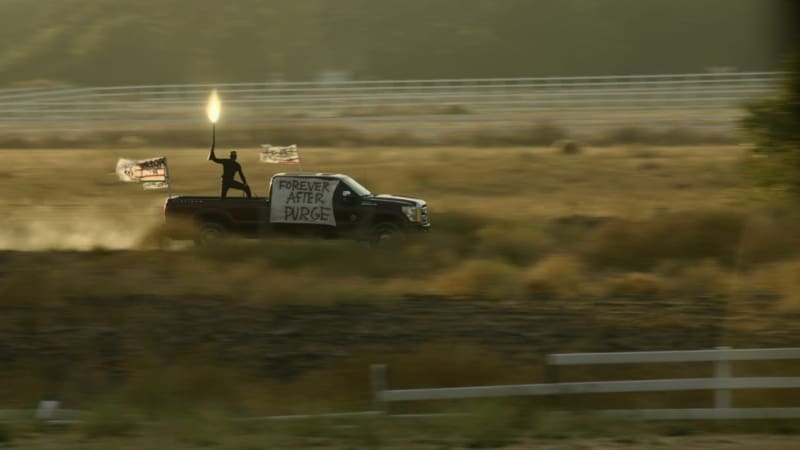‘The Forever Purge’ Finally Captures the Real America

While 2013’s The Purge features some social commentary around its kills, the film’s core exists primarily as a high-concept home invasion thriller. Since then, though, the franchise immediately grew to focus more directly on race and (to a lesser degree) class in both its motivation and execution. That trend continues with the fifth film, The Forever Purge, as it follows the franchise’s narrative to its logically overdue conclusion.
Adela (Ana de la Reguera) and Juan (Tenoch Huerta) are in love and in search of a dream, and both take them across the border from Mexico to the United States hoping for a better life. They succeed, and as their first annual Purge — the New Founding Fathers of America have regained control of the American government and reinstated the yearly event that was canceled at the end of The Purge: Election Year (2016) — approaches they gather with fellow immigrants under the protection of mercenaries. It’s an uneventful evening for them, but after the purge ends and they return to work they discover that some Americans have chosen to keep the holiday rolling.
The central premise of creator James DeMonaco‘s Purge films remains the epitome of brilliant nonsense, and while many questions have gone unanswered since the first film, one reigns supreme — are we really supposed to believe that Americans would simply forego committing crimes throughout the rest of the year and only unleash their inner assholery on a single day? That’s never made sense as it’s just not the way crime or criminals work. While The Forever Purge doesn’t answer the question directly, it does finally accept that humanity’s craving for violence, extremism, and hatred could never be held in check for long. The end result is a satisfying and occasionally tense action film that delivers the franchise’s most middle of the road entry.
The Forever Purge opens with a credits sequence featuring pleasant and wholesome drawings that then flip to darker, grimmer versions, and it sets the film’s themes of duality well. America is a beautiful place filled with freedoms and serenity, until it’s not. Our people are civilized, until they’re not. You’re safe if you respect America and its authority, until you’re not. That carries over to the film’s central characters too as Adela and Juan are joined by a wealthy white family, Juan’s employers, who also find themselves targeted by blue collar killers after the purge’s disregarded end.
For Dylan (Josh Lucas), his wife Cassidy (Cassidy Freeman), and her sister Harper (Leven Rambin), the purge has always been nothing more than a distraction. The patriarch of their family ranch, Caleb (Will Patton), thinks it’s a disgrace and even pays his employees a “purge protection bonus” to help keep them safe, but ultimately it is what it is. He does impart a sharp observation at the wrong end of a gun barrel, though, when he tells a masked thug mid-monologue on the evils of the one-percent that committing these acts of violence is basically doing the bidding of those very same Washington elites.
DeMonaco’s script and director Everardo Gout shift between the various protagonists before bringing them together, and while it’s not exactly news, it’s a depressing realization seeing so many people with so many excuses for their hatred. Race and class become the big buckets, but they’re filled with people who are unhappy with their lives, desperate to belong, irrationally afraid, and just plain stupid. The shared thread through it all is our willingness to hurt others, and unfortunately that’s far from a fictional creation. This new breed of purgers are the same from before — they’ve just decided their “patriotism” is too important and righteous to limit to a single night.
Gout crafts some solid enough set-pieces with The Forever Purge, both big and small, but the latter suffer at times as he and cinematographer Luis David Sansans shoot the action in unimpressive closeups. Fight scenes are so tightly cropped as to leave the details wanting, and while we can generally tell what’s happening and to whom they often struggle to deliver thrills. Gun battles are a bit more exciting as interiors and exteriors become war zones. The border city of El Paso takes on the appearance of an American Mosul with purgers spreading terror from the back of their flag-draped pickup trucks. Weak CG fire is overused in many of the wide shots, and the Blumhouse-mandated jumpscare music stingers remain ineffective, but neither element kills the film’s momentum.
The bigger issue in The Forever Purge falls to a third act that leans heavily into generic action territory. While the masked cowboys are heavily featured in marketing and the film’s first half, they fade away and are replaced by “white trash” neo-nazis. One of the recurring elements of the franchise has been the elaborate and often legitimately unsettling masks worn by the purgers, and ditching them for denim and ratty beards leaves much to be desired. Ironic plot turns pick up some of the slack as both Mexico and Canada open their borders to Americans fleeing the purge, and DeMonaco’s script earns points by referring to the echo of gunfire as “homegrown music from the heartland.” Your favorite country music station would never.
The Forever Purge is ultimately a mid-range effort for the franchise — it’s not as good or original as the first two films, but it’s more successful in its themes and execution than the last two — and if it ends here it does so on the bleakest of notes. The Purge: Election Year (2016) took the opposite route, and while both remain rooted in a fictional concept it’s the latest movie that winds up feeling closest to reality. Curiously, and somehow ingeniously, the film walks the line between being anti-NRA and pro-gun. Americans take up arms to fight the violently purging Americans who took up arms to fight the other Americans… and, yeah, welcome to America.





